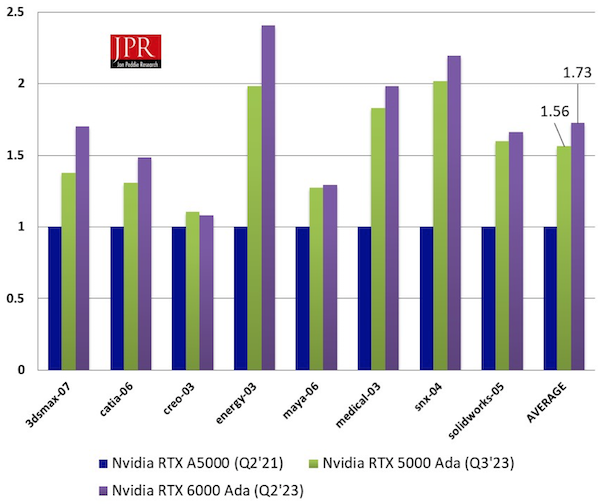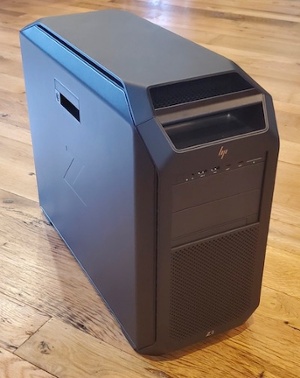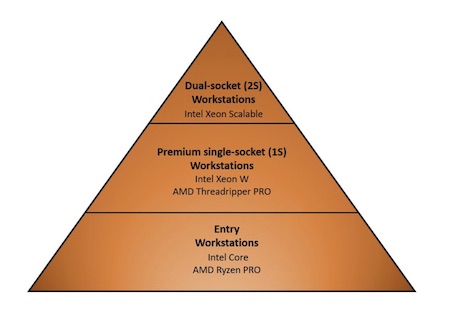Intel’s introduction of its 12th Generation Core processors represents one of the more meaningful events — with far broader implications than first meets the eye — in the evolution of workstation CPUs for CAD and other professional computing segments. The simple generational increment from 11 to 12 belies the significance of Alder Lake’s shift not only in technology but in Intel’s change in tack with respect to features, branding, and market positioning.
Judging this generation of CPU isn’t limited to the usual assessment of how much incremental performance it can yield over its predecessor. Rather, it’s worth considering how performance may now scale differently for your highly threaded workloads and how the Core brand has been tweaked specifically to better serve high demand, high reliability professional applications like CAD.
A Novel Hybrid Architecture Allowing Custom Configuration of Different CPU SKUs for Different Applications
As covered in detail in a previous column here, Alder Lake’s hybrid multi-core architecture will help unify the base processor technology for a wide range of performance and power levels in Intel’s portfolio. A single CPU is built on a mix of heterogenous cores, with one focused on performance (a P-core) and another on efficiency (an E-core). Intel can now shape one CPU product for lower-power mobile applications and a second for max-performance, power-hungry work, tapping the same architectural foundation. Go a bit heavier on E-cores for those sockets that want to constrain watts, and choose more P-cores when throughput is the overwhelming priority.
What Performance Can CAD Users Expect?
In its marketing collateral, Intel promised a general 19% IPC improvement across workloads, a figure that worth noting exactly matches the advertised figure for both Intel’s previous Rocket Lake S microarchitecture as well as AMD’s Ryzen 5000 family, introduced last year. But as I often emphasize, such figures need to be taken with a grain of salt for two reasons. One, while vendors rarely intentionally deceive, they will of course want to put their best foot forward, sometimes highlighting benchmarks that — while legitimate — tend to show their better results, while giving less-flattering scores short shrift. Two, performance varies greatly by workload, with any one user unlikely to stress his or her system in precisely the same way any benchmark does. And three, that user’s system may see bottlenecks in other areas — like memory, storage, or graphics — that the vendor’s testing specifically avoids.
To mitigate — but of course not eliminate — such performance claim caveats, I did my own testing of an Alder Lake CPU, specifically focusing attention on common workloads for professional computing use, particularly for CAD.

This month, we’ll benchmark HP’s Z2 Mini workstation’s 12th Generation Core i9-12900K CPU against its predecessor, the Rocket Lake i9-11900K and the Xeon W-2265. Watch for more about this mini form factor next month. Image source: HP.
HP’s Z2 Mini Workstation as Alder Lake Test System
As luck would have it, HP made available a just-refreshed G9 version of their diminutive — but very capable — Z2 Mini workstation. There’s a lot more to cover about the Z2 Mini — and comparable ultra-small form factor workstations — than its CPU. Check out next month’s column for a closer look at what the Z2 Mini can offer those looking to reduce their system footprint but want to stick with a fixed, line-powered workstation over a mobile.
This month, though, I’m going to focus on Alder Lake, taking advantage of the chance to benchmark the Z2 Mini’s 12th Generation Core i9-12900K CPU. The top of the 12th Generation Core line, the i9-12900K implements a balanced mix of P-cores and E-cores, eight of each. Firmly positioned to spread across mainstream price points for high-performance desktop/deskside systems — gaming PCs and workstations, primarily — the i9-12900K is by no means some niche boutique SKU, but it would sit a tad north of the workstation market’s sweet spot. And in that spot, it looks to serve buyers who previously might opt for a lower-end Xeon W CPU and an upper-end 11th Generation Core CPU (the Rocket Lake generation previously covered here).
So how does the new Alder Lake Core i9-12900K compare to its predecessor, the Rocket Lake i9-11900K, and the (now aged) Xeon W-2265, with 12 cores perhaps the most relevant comparison from the Xeon W line? Below are the test results from the very CAD-oriented and multi-threaded (MT) Product Development test suite in SPECworkstation, run on comparably outfitted (i.e., a very fast GPU and similar storage drives) workstations. Each outfitted with GPUs that should never represent the bottleneck, along with essentially identical I/O subsystems, scores should predominantly reflect the performance limitations of the CPU, rather than any other link in the system’s performance chain.
SPECworkstation Product and Development scores: Alder Lake 8+8C Core i9-12900K and 12C Xeon W-2265, normalized to the 11th Generation Core i9-11900K. Click image to enlarge.
Normalized to the slowest platform running MT workloads, the 8C Core i9-11900K, 12th Gen Core Alder Lake not only crushed the MT performance of Rocket Lake, by 62% in aggregate, it leaped past the Xeon W-2265 by 41%. Both figures far exceed the nominal 19% IPC Intel’s marketing suggests, though that’s understandable, because IPC growth relates to a single-thread, and here SPECworkstation is running MT-heavy workloads, exploiting more cores in Alder Lake.
Apples and (Mostly) Apples
The specifications for this trio of CPUs raise an obvious issue of whether we’re making fair comparisons running MT workloads like SPECworkstation Product and Development tests. In terms of raw core counts, the 11th Gen Core i9 is an 8-core model (8C), while the Xeon W-2265 is a 12C model, and the 12th Gen Core i9-12900K offers 16 cores. Compared to the 8C 11th Gen, it is and it isn’t. Yes, the 12th offers more core capabilities, so it should have the obvious advantage in multi-thread workloads. But from a market perspective, the two are positioned at the same point with similar prices, so the 12th Gen Core i9-12900K is a perfect comparison to its predecessor Core i9-11900K, illustrating exactly benefits the next generation can offer at the same point in the market.
The 12C Xeon W-2265 comparison is a bit trickier. Yes, it also has fewer cores than the 16C i9-12900K, but because of the hybrid architecture introduced in Alder Lake, it’s possibly an advantage, as all of the W-2265’s 12 cores were essentially P-cores (though not called that at the time) compared to only 8 on Alder Lake. Meanwhile, the latter offers more overall cores, albeit to some degree slower. Given all that, it might be fairest to compare an old-school 12C with the new hybrid 8P+8C model, though viewers of the results should bear in mind the differences.
Moreover, while as of this writing, while the Xeon W-2265 still ships in vendor’s Xeon-centric premium-positioned single-socket workstations, it’s now quite old and later this year (presumably) will be succeeded by Sapphire Rapids bearing the Xeon brand. Sapphire Rapids will leverage the same foundation of P-cores and E-cores that Alder Lake does, though in an as-yet-to-be-determined mix, along with higher performance memory. That is, a Sapphire Rapids Xeon W, due out before the end of the year, should outperform the Xeon W-2200 series by an even more substantial margin than our 12th Gen Core i9-12900K tested here.
Comparing single-thread (1T) performance is more straight-forward, without any disclaimers necessary regarding P-core versus E-core counts. In the case of Alder Lake, a single high-demand thread will in all likelihood get handed off to a P-core. That’s no different than for 11th Gen Rocket Lake nor the Xeon W-2265, both of whose cores were engineered for performance first (though not designated as such back then). And we should expect the Xeon W-2200 series’ successor Sapphire Rapids would exhibit comparable 1T performance as our 12th Gen i9-12900K.
Unfortunately, SPECworkstation does not currently offer a 1T test, so as I’ve done in the past, I turned to Cinebench R20 (a rendering benchmark) and PassMark’s PerformanceTest 10.2, which comprises CPU tests that can be constrained to single-thread execution. No surprise, the 12th Gen Core i9-12900K outperformed the older Xeon W by a wide margin, 54% on average, while putting up 29% higher scores than Rocket Lake. The 29% at 1T is a more appropriate comparison to an IPC improvement, still besting even Intel’s marketing figure. The chart below shows scores normalized to the slowest 1T processor among our trio, the Xeon W-2265.
Single-thread benchmark results: Alder Lake Core i9-12900K and 11th Generation Core i9-11900K, normalized to the 12C Xeon W-2265. Click image to enlarge.
Performance Scaling Changes with New Hybrid Architecture
Beyond simply assessing gains in bottom-line performance for one SKU in a generation executing some number of threads, it’s worth looking at how Alder Lake scales performance as a function of core and thread counts. Why? Because with this hybrid architecture, any incremental thread added to the workload won’t necessarily get the same performance treatment as the thread prior. That’s because at some point, an Alder Lake will run out of P-cores to employ and be forced to enlist E-cores instead. And since E-cores, by design, won’t deliver the same performance, we’ll now see performance scale at diminishing returns at core counts increase.
That behavior is illustrated quite well using PerformanceTest 10.2’s ability to repeat tests with ascending threads, starting from one up to the count specified. In the chart below, I show how performance scales running PerformanceTest 10.2’s Floating Point test with ascending thread count on the i9-12900K compared to the old Xeon W-2265. Importantly, what is charted is the SKU’s performance multiple at the given thread count relative to its own 1T performance to ascertain how well it scales, which is why both start at the same value of 1. As more threads are thrown at the Xeon W-2265, performance scales quite linearly, while the 12th Gen Core shows the expected split personality. Up to 8 threads, corresponding to the number of available P-cores, performance climbs linearly, but subsequent per-core gains notably decline, as E-cores are enlisted for incremental threads thereafter.

How performance scales as a function of thread count for the 8+8C Core i9-12900K versus the 12C Xeon W-2265 (PerformanceTest 10.2’s Floating Point test).
Alder Lake on Fixed/Desktop Workstations Just the Start, as Alder Lake for Mobile Workstations Show an Even More Impactful Change
Leveraging the same unifying, hybrid architectural foundation as its desktop-focused siblings, Alder Lake for mobiles had already been launched, code named Alder Lake-H and bearing the same 12th Generation Core brand. The -H suffix has distinguished SKUs targeting high-performance mobile applications, such as mobile workstations for CAD, long settled on a de facto norm of 45 watts power envelope. That 45 watts was a level that both the CPU supplier and system vendor could agree on as providing best-case performance, without requiring boutique cooling solutions and decimating battery life to unacceptable levels.
Given that, with the Alder Lake-H launch I’d assumed we’d seen the extent of Alder Lake CPUs for use in mobile workstations. That assumption was wrong, as Intel has just announced another product tier for the high-performance mobile CPUs: Alder Lake-HX. Given that, power scales linearly with frequency and the square of the voltage, bumping that Alder Lake-H 45 W budget up to the -HX’s 55 W could theoretically be spent on more cores running at the same voltage and frequency or the same cores running with faster clocks.

Intel’s Alder Lake-HX CPU offers a significant bump in power (55 W), translating to more available mobile workstation performance.
What did Intel do with increased power budget? Well, first off, it stole a few more watts from the -H series by downgrading the capability — and therefore power consumption — of the -HX integrated GPU. Doing so was a very sensible move, since a top-performance mobile workstation is highly likely to be paired with a discrete GPU anyway, freeing up more watts for the CPU.
From there, Intel focused on building the -HX’s MT performance with more cores, specifically more P-cores. The 45 W Alder Lake-H Core i7 SKUs already lean heavier to E-cores, with 8 implemented alongside 4 to 6 in the i7 family, as sensible given the far lower power allotment compared to the desktop’s typical 125 W budget. Taking advantage of the extra available power, the -HX i7 and i9 families stick with 8 E-cores, but bump up the P-core count from a max of 6 to a max of 8. Not only are the P-cores faster per thread, but bear in mind that P-cores support dual-thread concurrent HyperThreading, so an 8P/8E 16C -HX CPU can concurrently execute 24 threads, while a 6P/8E -H SKU can only manage 20.
In terms of clock rate, Intel maintained the same max Turbo Frequency for the -HX as the -H series, at 5 (i9) and 4.8 (i7), while dropping the base frequencies a touch. Worth remembering is that while heavy MT processing will tend to track base frequency, 1T execution can often be sustained at the higher Turbo rates.
A sampling of 12th Generation Core 55 W -HX compared to 45 W -H parts. Data source: Intel. Click to enlarge.
Given that, the new 55 W level will allow mobile workstations to further close the performance gap to line-powered fixed workstations for MT workloads like rendering and simulations. But if your overriding priority is 1T processing, common in modeling and interactive graphics, the -H will do as well as the -HX series.
Expect virtually every workstation vendor to adopt the 12th Generation Core -HX parts in their performance-first (versus mobility-first) mobile models. HP has already announced support for its max-performance Fury-branded mobile line.
Xeon Moving to Niche Usage in Workstations. . . and Intel’s OK with It
I did not see this coming. Intel has for a long time stressed its marketing position that a machine needed to sport a Xeon CPU to truly be called a workstation. Neither I nor the market has agreed with that, and the latter has spoken by pushing Core to dominant market position as of late. In the past, it had various degrees of success partnering with OEMs to increase Xeon’s share of the workstation market. However, due to both the rapid rise of Entry 1S class systems as well as OEMs being pushed to offer Core-brand CPUs in both Entry 1S and even Premium 1S workstations, Core has come roaring back in workstation platform penetration. It now accounts for a significant majority in fixed machines compared to Xeon, and it virtually owns the mobile space.
But rather than fight to reinforce Xeon’s position as the workstation processor of choice, it now looks like Intel has decided to switch instead. One indication is the company’s choice to make Error Correction Code (ECC) support available in Core-brand CPUs for the first time with the introduction of 12th Generation Alder Lake.
Beyond its dual-socket support, only relevant at the very highest reaches of the workstation market, Xeon’s advantage over Core in features has historically been mostly limited to very high core counts (beyond the mainstream), more memory channels (four versus Core’s two) and ECC memory. Those features were specifically and intentionally maintained exclusive to Xeon to help entice CAD users to buy up from Core to Xeon. However, starting in 2022 with 12th Generation Core, one of those is now no longer exclusive, as ECC support will now be available on Core.
Ultimately, and ironically, it is Intel itself that is dampening that mission to establish Xeon as the de facto choice for workstation buyers. While Sapphire Rapids Xeon coming later this year should still offer the same advantages in faster memory and higher core-count SKUs — likely very well suited to the upper end of the CAD workstation market — Xeon won’t be as enticing to any buyers in the mainstream as it may have been in the past.
No doubt about it, Intel’s 12th Generation Core introduction marks a departure for Intel, one reflected in several strategic choices and sure to be reinforced with the introduction of Sapphire Rapids Xeon later this year. The new hybrid architecture first unveiled in Alder Lake not only delivers the usual generation-to-generation gains in performance, it’s unifying the company's technology foundation across fixed and mobile platforms. At the same time, it’s boosting the top-end power for mobile platforms, allowing vendors to crank up the performance a mobile workstation can achieve that much further. And with ECC now available under the Core brand, and offering a big jump in available core count from 8C to 16C — enough to satisfy the vast majority of CAD users — Intel now seems to accept that Core will be the de facto CPU for mainstream CAD workstation computing.
Alex Herrera
With more than 30 years of engineering, marketing, and management experience in the semiconductor industry, Alex Herrera is a consultant focusing on high-performance graphics and workstations. Author of frequent articles covering both the business and technology of graphics, he is also responsible for the Workstation Report series, published by Jon Peddie Research.
View All Articles








Share This Post